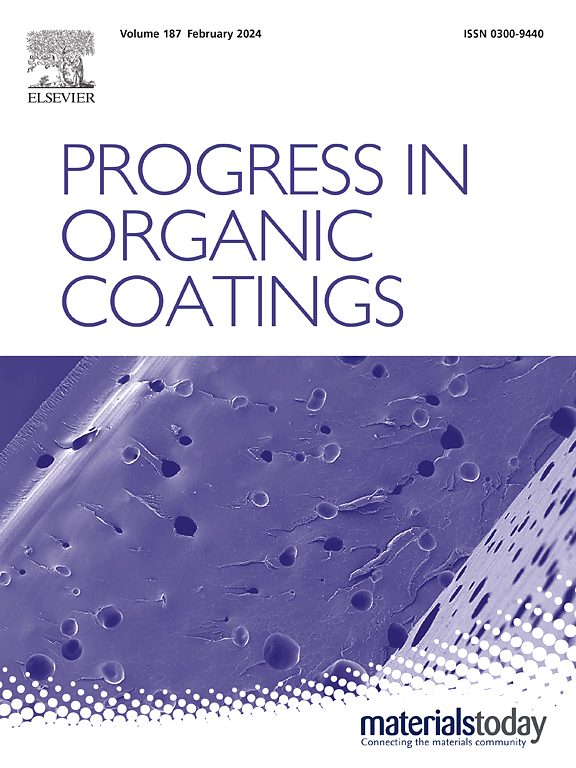Enhanced mechanical and tribological performance of epoxy nanocomposite coating by non-covalent bonded h-BN nanosheets/graphene oxide
IF 7.3
2区 材料科学
Q1 CHEMISTRY, APPLIED
引用次数: 0
Abstract
Developing high-performance of organic solid lubricating coating is of great significance for extending the life of the moving systems/parts. Herein, the non-covalently modified h-BN nanosheets by graphene oxide (BNNSs/GO) were elaborately constructed to enhance the mechanical, friction and wear properties of epoxy nanocomposite coating. The microstructure feature and chemical composition of BNNSs/GO were determined by various spectroscopic techniques. The tribological performance of nanocomposite coatings were tested using ball-on-disc friction tester, and 440C stainless-steel ball with diameter of 8 mm was used as the counterface material. The GO nanosheets acted an active platform for BNNSs, which improved the dispersion of BNNSs and interface interaction with epoxy. The anchoring BNNSs could break the strong π-π, and van der Walls forces among GO nanosheets. The thickness of epoxy nanocomposite coatings was about 60 μm. And the epoxy-1.0 wt%BNNSs/GO demonstrated much higher hardness and elastic modulus than epoxy, increased by 112.62 % and 53.37 %, respectively. The coefficient of friction (COF) and wear rate of epoxy-1.0 wt%BNNSs/GO were the lowest, with a reduction of 89.7 % and 97.5 %, respectively. The synergistic lubricating mechanism of epoxy-BNNSs/GO coating was proposed, which could provide a new light on the design of high antifriction and wear resistance of organic nanocomposite coating.
用非共价键合的 h-BN 纳米片/氧化石墨烯提高环氧纳米复合涂层的机械和摩擦学性能
开发高性能的有机固体润滑涂层对于延长运动系统/部件的使用寿命具有重要意义。本文精心构建了氧化石墨烯非共价改性 h-BN 纳米片(BNNS/GO),以提高环氧纳米复合涂层的机械、摩擦和磨损性能。通过各种光谱技术测定了 BNNSs/GO 的微观结构特征和化学成分。使用球盘摩擦试验机测试了纳米复合涂层的摩擦学性能,并使用直径为 8 mm 的 440C 不锈钢球作为摩擦面材料。GO 纳米片是 BNNSs 的活性平台,它改善了 BNNSs 的分散性以及与环氧树脂的界面相互作用。锚定的 BNNSs 可以打破 GO 纳米片之间强大的 π-π 力和范德华力。环氧纳米复合材料涂层的厚度约为 60 μm。环氧-1.0 wt%BNNSs/GO 的硬度和弹性模量比环氧树脂高得多,分别提高了 112.62 % 和 53.37 %。环氧-1.0 wt%BNNSs/GO 的摩擦系数(COF)和磨损率最低,分别降低了 89.7 % 和 97.5 %。提出了环氧-BNNSs/GO 涂层的协同润滑机理,为设计高减摩耐磨的有机纳米复合涂层提供了新的思路。
本文章由计算机程序翻译,如有差异,请以英文原文为准。
求助全文
约1分钟内获得全文
求助全文
来源期刊

Progress in Organic Coatings
工程技术-材料科学:膜
CiteScore
11.40
自引率
15.20%
发文量
577
审稿时长
48 days
期刊介绍:
The aim of this international journal is to analyse and publicise the progress and current state of knowledge in the field of organic coatings and related materials. The Editors and the Editorial Board members will solicit both review and research papers from academic and industrial scientists who are actively engaged in research and development or, in the case of review papers, have extensive experience in the subject to be reviewed. Unsolicited manuscripts will be accepted if they meet the journal''s requirements. The journal publishes papers dealing with such subjects as:
• Chemical, physical and technological properties of organic coatings and related materials
• Problems and methods of preparation, manufacture and application of these materials
• Performance, testing and analysis.
文献相关原料
公司名称
产品信息
阿拉丁
h-BN powder
 求助内容:
求助内容: 应助结果提醒方式:
应助结果提醒方式:


